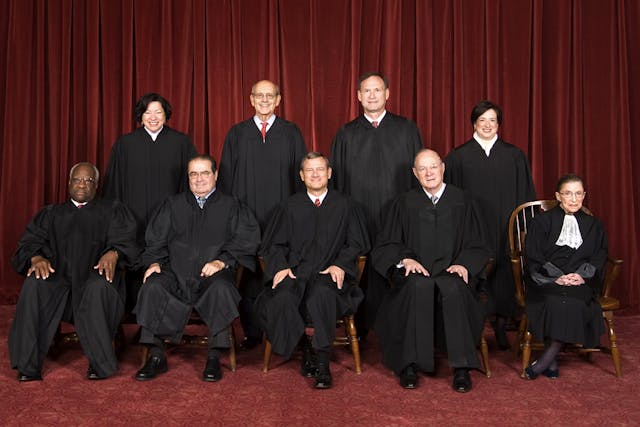
Illinois abortion facilities injured 21 women in 2025
Nancy Flanders
·
NYT’s “reincarnation of pro-life” desperately hopes Roe will rise from the ashes
The New York Times published an interesting piece by Emily Bazelon yesterday. Bazelon is actually the pro-abortion journalist whose 2009 interview with Justice Ruth Bader Ginsburg yielded the Justice’s infamous admission of the eugenic basis for abortion: “Frankly I had thought that at the time Roe was decided, there was concern about population growth and particularly growth in populations that we don’t want to have too many of.”
Bazelon’s new article, titled, “The Reincarnation of Pro-Life,” is ostensibly about the contemporary strategy and victories of the pro-life movement, i.e., the movement’s “reincarnation,” but it actually reads more like a desperate attempt to convince the reader (or perhaps the author) that Roe v. Wade and pro-abortion jurisprudence will be able to rise from their own impending ashes. After just two paragraphs, Bazelon rather conspicuously segues from reporting on pro-life victories to fear-mongering about abortion access:
Taken together, these new state laws are hugely effective — incrementalism on steroids.
Naturally, abortion rights advocates are terrified by this. On a recent episode of her show, Rachel Maddow presented a map demonstrating how hard it is to get an abortion across large swaths of the country. It was a reminder of just how long some women could have to spend on a bus to get to a clinic.
Maddow then suggested that the laws are going unchallenged and that the abortion rights movement is in disarray. Maddow’s guest that night — Terry O’Neill, president of NOW — told her that people on their side were gun shy, afraid to bring a suit that could end up in the Supreme Court and thus test Justice Anthony Kennedy. Two decades ago, Kennedy was crucial to the 5-to-4 watershed decision to uphold Roe in Planned Parenthood v. Casey. But that was before Samuel Alito, an abortion opponent, replaced Sandra Day O’Connor, one of Kennedy’s co-authors in Casey. Now that Kennedy is in the company of four avowed conservatives, should abortion rights advocates stay out of court entirely if that’s what it takes to maintain the constitutional status quo? “I understand how this has happened,” Maddow said. “I do not understand how it ends.”

Bazelon has a strong rebuke for Maddow that is a fascinating summary of the current pro-abortion legal strategy:
But here’s where Maddow and the other worriers are wrong: litigators trying to uphold a woman’s right to an abortion are not running scared. In fact, they are being remarkably shrewd in their case selection. They’re bringing suits all over the country — they’re just not challenging every single state restriction, no matter where it’s enacted or how many women it affects. “We don’t jump when the other side says ‘Jump,’ ” says Nancy Northup, president of the Center for Reproductive Rights.
The bait that they have been wise to avoid involves the prohibition of abortion after 20 or 22 weeks of pregnancy.
Bazelon’s statement should have one caveat: pro-abort litigators definitely ARE “running scared”–they are running scared of new, innovative pro-life legislation that most directly challenges Roe v. Wade. Not only is the limited case selection of the other side “remarkable,” as Bazelon says–a better word would be “ironic.” Up until now, it’s been hard to find a pro-life law that Planned Parenthood, NARAL, NOW, the ACLU, or CRR have not challenged in court. Nancy Northup’s statement is such an about-face that she might need to see a chiropractor.
But dutifully ignoring the irony, Bazelon continues the remainder of her article with a pep talk for pro-aborts about their new legal strategy:
Article continues below
Dear Reader,
In 2026, Live Action is heading straight where the battle is fiercest: college campuses.
We have a bold initiative to establish 100 Live Action campus chapters within the next year, and your partnership will make it a success!
Your support today will help train and equip young leaders, bring Live Action’s educational content into academic environments, host on-campus events and debates, and empower students to challenge the pro-abortion status quo with truth and compassion.
Invest in pro-life grassroots outreach and cultural formation with your TRIPLED year-end gift!
Instead, lawyers representing their side have been challenging the laws that hurt women most — which are also the ones most likely to sway public opinion back to their side. […] In a 2007 poll, Gallup found that twice as many people favor making late-term abortion illegal than favor overturning Roe (72 percent versus 35 percent).
Abortion rights advocates are also trying to prevent South Dakota from mandating that women wait a full 72 hours for an abortion. This comes on the heels of a lawsuit that challenges the requirement that mandatory counseling include the claim that abortion is linked to an increased risk of suicide (there is no reliable evidence to support this). In Casey, the Supreme Court allowed states to impose only a 24-hour waiting period and to require counseling that accurately explained the stages of fetal development. The South Dakota law is far out enough that when I asked Yoest about it, she said only, “That’s not one of our pieces of legislation.” If the battle reaches the Supreme Court, there’s presumably little chance that Justice Kennedy would sign off on requiring doctors to read a script of made-up data posing as facts.
These are precisely the kinds of cases that lawyers in support of reproductive rights should pursue, because they portray abortion foes as radical. The South Dakota fight shows that in the name of protecting women, abortion opponents are willing to demean them — by forcing them to visit a crisis pregnancy center and listen to unsupported medical claims.
I was rather shocked to read the bolded sentence from Bazelon. As a pro-abortion legal scholar, she should be very familiar with the criticism for “paternalsim” and supporting “junk science” Justice Kennedy received after his majority opinion in Gonzales v. Carhart strongly asserted the states’ interest in protecting women from the trauma of abortion. In fact, Bazelon herself partook of this criticism in her 2009 interview with Ginsburg and in 2008, when she scathingly referenced “the heap of paternalism that Justice Anthony Kennedy started climbing two years ago, in his opinion in Gonzales v. Carhart.” Bazelon should back down from the heap of wishful thinking she is climbing if she thinks Justice Kennedy will be sympathetic to the abortion lobby’s arguments that waiting periods and informed consent for abortion are “radical.”
If Bazelon & co. think South Dakota’s new law is “radical,” what must they think of the 20-week bans in NE, IN, and ID? Rachel Maddow and Terry O’Neill stated it plainly–they are some of the scariest boogeymen hiding under the surgical bed right now for pro-aborts. Bazelon writes obtusely that these laws are not being challenged for political reasons:
The bait that they have been wise to avoid involves the prohibition of abortion after 20 or 22 weeks of pregnancy. Abortion foes coined the term “partial-birth abortion” in the mid-1990s for a particular late-term procedure and later persuaded the Supreme Court to uphold Congress’s ban. Along the way, they reduced popular support for reproductive rights more broadly by making late-term abortion seem as if it were the norm rather than the exception. Yet only 1.5 percent of abortions occur late in the second trimester. And in three of the five states that recently banned the procedure, no doctor provided late-term abortions anyway. In other words, these particular restrictions are largely symbolic. If the abortion rights groups were to sue, they would risk returning to dangerous political ground.
Bazelon is naive to think that the only reason these laws are not being challenged is because of the effect a public debate on late-term abortion will have on the popular consciousness. The real reason is, as Maddow and O’Neill noted, that the 20-week bans directly confront Roe‘s viability standard. Bazelon suggests that because these bans will only affect a small portion of abortions, her movement can let them slide for now, but this is shockingly myopic. What will they do, then, when confronted with Ohio’s proposed “Heartbeat Bill,” which will ban virtually all abortions in that state? What will they do when confronted with Mississippi’s Personhood amendment, which is almost certain to pass this fall? These laws are not “largely symbolic”–these are the effective abortion bans we have been waiting for.
Pro-abortion legal activists like Bazelon and Northup are trying to fight pro-life laws like it’s still the 1990s–they are litigating the sort of waiting period and informed consent cases they would have 20 years ago. The real fight is with innovative new laws that challenge Roe‘s studied inattention to the humanity of the unborn child, and so long as pro-abortion litigants continue to run from that fight, we should continue to legislate all over them.
Live Action News is pro-life news and commentary from a pro-life perspective.
Contact editor@liveaction.org for questions, corrections, or if you are seeking permission to reprint any Live Action News content.
Guest Articles: To submit a guest article to Live Action News, email editor@liveaction.org with an attached Word document of 800-1000 words. Please also attach any photos relevant to your submission if applicable. If your submission is accepted for publication, you will be notified within three weeks. Guest articles are not compensated (see our Open License Agreement). Thank you for your interest in Live Action News!

Nancy Flanders
·
Opinion
Angeline Tan
·
Issues
Angeline Tan
·
Guest Column
Emily Berning
·
Opinion
Nancy Flanders
·
Opinion
Mark Wiltz
·
Guest Column
David Daleiden
·
Guest Column
David Daleiden
·
Politics
David Daleiden
·![In a MyFoxNY story: The case made national headlines: A botched abortion in Florida and an elaborate cover-up. The physician involved — Dr. Pierre Renelique — was banned from practicing medicine there. But nine months after Florida revoked his license, he is seeing patients in the Bronx. Fox 5’s Arnold Diaz tracked him down for […] abortion, abortionist](https://www.datocms-assets.com/131250/1749494910-abortionist.jpg?auto=format%2Ccompress&fit=crop&h=142&w=213)
Issues
David Daleiden
·
Issues
David Daleiden
·